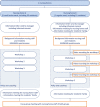Feasibility of DAIly NURSE: A nursing intervention to change nursing staff behaviour towards encouraging residents' daily activities and independence in the nursing home
- PMID: 30230069
- PMCID: PMC7380124
- DOI: 10.1111/jocn.14677
Feasibility of DAIly NURSE: A nursing intervention to change nursing staff behaviour towards encouraging residents' daily activities and independence in the nursing home
Abstract
Aims and objectives: To examine the feasibility of DAIly NURSE and a nursing intervention to encourage nursing home residents' daily activities and independence.
Background: Nursing home residents are mainly inactive during the day. DAIly NURSE was developed to change nursing behaviour towards encouraging nursing home residents' activities and independence by creating awareness. It consists of three components: education, coaching-on-the-job and policy.
Design: A mixed-method study.
Methods: The feasibility of DAIly NURSE in practice was tested in six psychogeriatric nursing home wards, using attendance lists (reach), evaluation questionnaires (fidelity, dose received and barriers), notes made by the researcher (dose delivered and fidelity) and a focus group interview (dose received and barriers) with nursing home staff (n = 8) at the end of the study.
Results: The feasibility study showed that all three components (education, coaching-on-the-job and policy) were implemented in practice. The attendance rate in the workshops was high (average: 82%). Nursing home staff were satisfied with the workshops (mean score 9 out of 10 points) and agreed that DAIly NURSE was feasible in daily nursing care practice. Recommendations to optimise the feasibility of DAIly NURSE included the following: Add video observations of a specific moment of the day to create awareness of nursing behaviour; educate all nursing staff of the ward during the workshops; and organise information meetings for family members before the start of the intervention. Nursing staff were satisfied with the intervention and provided recommendations for adjustments to the content of the three components. The most important adjustment is the use of video observations to create awareness of nursing staff behaviour.
Conclusions: DAIly NURSE, consisting of education, coaching-on-the-job and policy, is feasible in nursing home practice.
Relevance to clinical practice: DAIly NURSE might help to change nursing behaviour towards encouraging residents' daily activities and independence.
Keywords: activities of daily living; awareness; behaviour change; encouragement; feasibility studies; independence; nursing home residents; nursing homes; nursing intervention; nursing staff.
© 2018 The Authors. Journal of Clinical Nursing Published by John Wiley & Sons Ltd.
Conflict of interest statement
The authors declare no conflict of interests.
Figures
Similar articles
-
Development and usability of the MAINtAIN, an inventory assessing nursing staff behavior to optimize and maintain functional activity among nursing home residents: a mixed-methods approach.BMC Health Serv Res. 2016 Feb 2;16:38. doi: 10.1186/s12913-016-1288-7. BMC Health Serv Res. 2016. PMID: 26837812 Free PMC article.
-
Do nursing staff encourage functional activity among nursing home residents? A cross-sectional study of nursing staff perceived behaviors and associated factors.BMC Geriatr. 2017 Jan 14;17(1):18. doi: 10.1186/s12877-017-0412-9. BMC Geriatr. 2017. PMID: 28088168 Free PMC article.
-
Nursing home residents' perspectives on their social relationships.J Clin Nurs. 2020 Apr;29(7-8):1162-1174. doi: 10.1111/jocn.15174. Epub 2020 Jan 22. J Clin Nurs. 2020. PMID: 31889360 Free PMC article.
-
Guide Map for Preserving Remaining Ability of Nursing Home Residents With Physical-Cognitive Functional Decline.J Contin Educ Nurs. 2017 Feb 1;48(2):73-80. doi: 10.3928/00220124-20170119-08. J Contin Educ Nurs. 2017. PMID: 28135381 Review.
-
Understanding the Barriers and Enablers to Using Outdoor Spaces in Nursing Homes: A Systematic Review.Gerontologist. 2020 May 15;60(4):e254-e269. doi: 10.1093/geront/gnz055. Gerontologist. 2020. PMID: 31218352 Free PMC article.
Cited by
-
Interventions to foster family inclusion in nursing homes for people with dementia: a systematic review.BMC Geriatr. 2020 Oct 30;20(1):434. doi: 10.1186/s12877-020-01836-w. BMC Geriatr. 2020. PMID: 33126855 Free PMC article.
-
Implementation of interventions to maintain and promote the functional mobility of nursing home residents - a scoping review.BMC Geriatr. 2023 Sep 26;23(1):600. doi: 10.1186/s12877-023-04213-5. BMC Geriatr. 2023. PMID: 37752436 Free PMC article.
-
How to spark the potential of research in nursing students?J Family Med Prim Care. 2024 Aug;13(8):3447-3448. doi: 10.4103/jfmpc.jfmpc_344_24. Epub 2024 Jul 26. J Family Med Prim Care. 2024. PMID: 39228556 Free PMC article. No abstract available.
-
A Quasi-experimental study on prevention and reduction of involuntary treatment at home (PRITAH) in people with dementia.J Clin Nurs. 2022 Nov;31(21-22):3250-3262. doi: 10.1111/jocn.16163. Epub 2021 Dec 7. J Clin Nurs. 2022. PMID: 34878198 Free PMC article.
References
-
- Blair, C. E. (1995). Combining behavior management and mutual goal setting to reduce physical dependency in nursing home residents. Nursing Research, 44, 160–165. - PubMed
-
- Blankevoort, C. G. , van Heuvelen, M. J. , Boersma, F. , Luning, H. , de Jong, J. , & Scherder, E. J. (2010). Review of effects of physical activity on strength, balance, mobility and ADL performance in elderly subjects with dementia. Dementia and Geriatric Cognitive Disorders, 30, 392–402. 10.1159/000321357 - DOI - PubMed
MeSH terms
Grants and funding
LinkOut - more resources
Full Text Sources
Other Literature Sources
Medical




